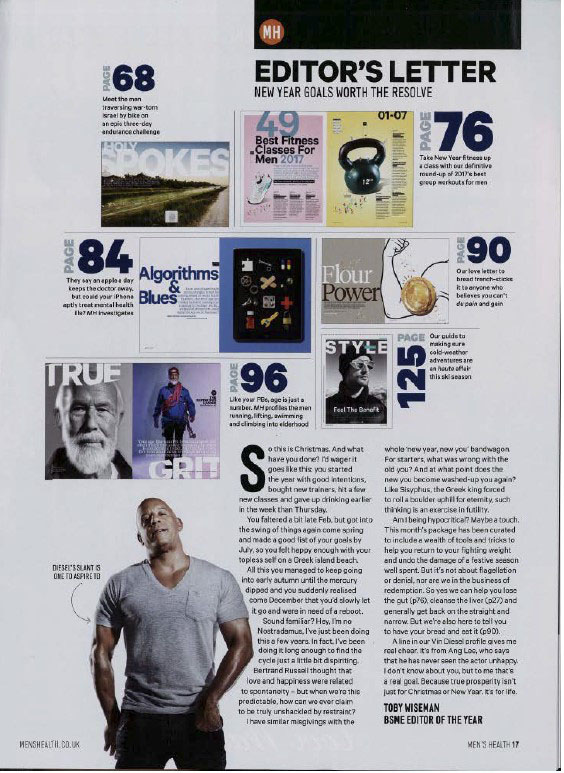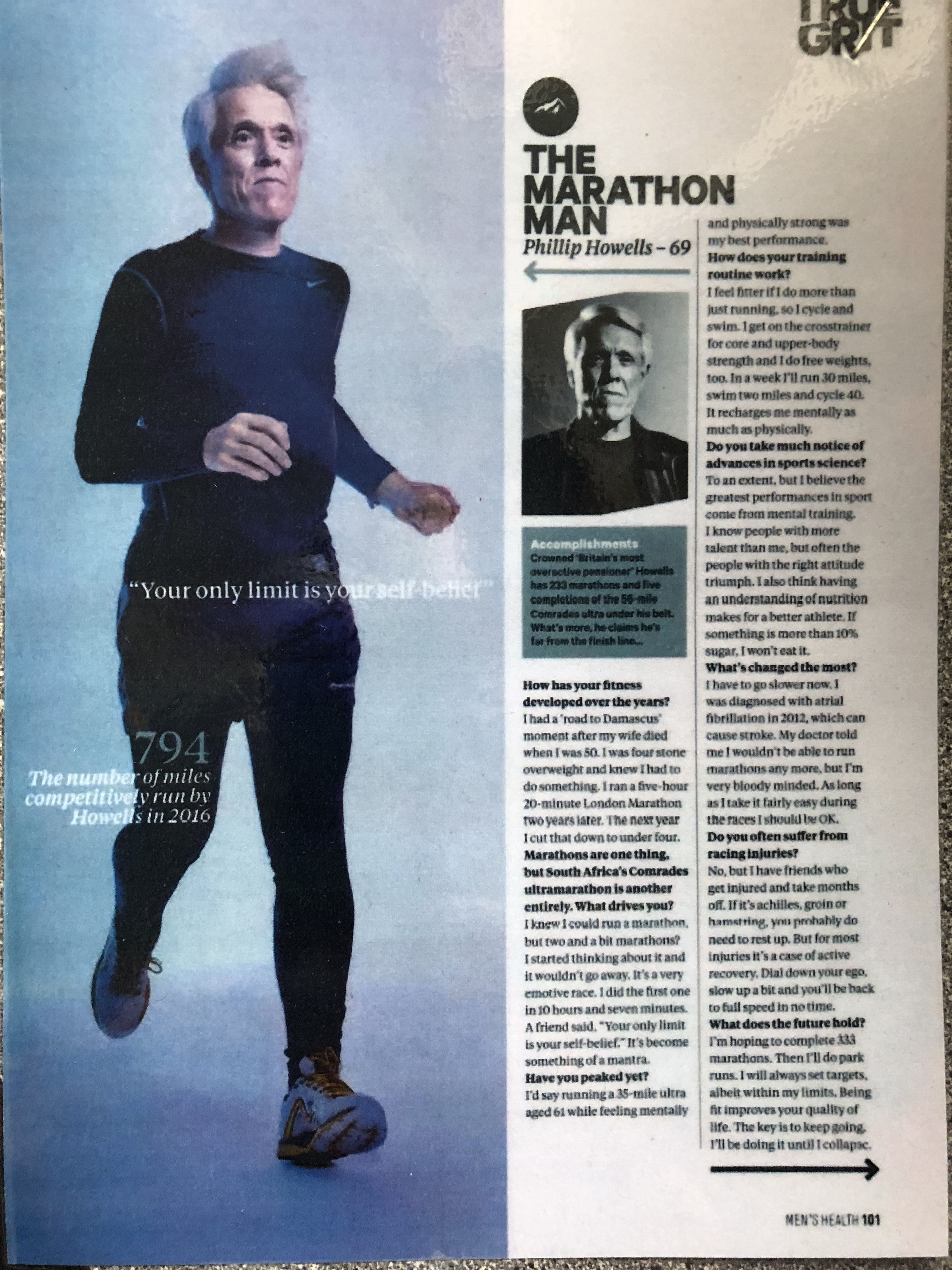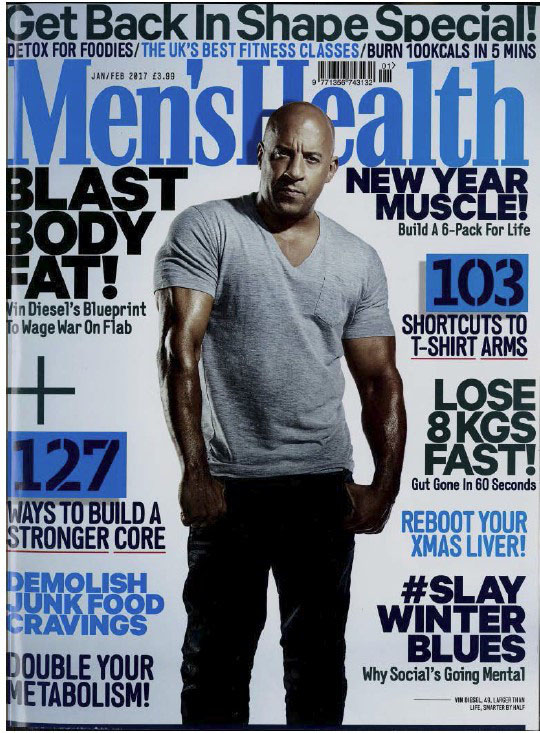
Semiotics: how images signify cultural meanings
The dominant signifier (the actor Vin Diesel) in the image is the man stood in the front of the magazine, he is dominating the page and is the anchorage which more directly relates to the masthead which illustrates the message of the magazine which is ‘Men’s Health’. The use of a famous actor as the dominant signifier is used as a method to sell more magazines as a way for the target audience to trust the message of the magazine greater. There is a large syntagm of indexical signs, phrases and subheadings all following a theme of unrealistic conventions of health and how to lose weight.
The use of the dominant colouring of blue followed by headings such as ‘Best fitness classes for men’ shows a clear male target audience. The media naturalises ideas through repetition meaning the repeated use of similar phrases and themes of fitness is obviously the focal point of the magazine.
When evaluating the magazine it can be assessed that it follows a reactionary view. This is because when the magazine was made (early 2017) there was a more shallow and elementary view on fitness so it illustrates a conventional view on health for the time. But when applying more modern views on fitness and health, it may be considered a negative radical field due to the statements such as ‘103 shortcuts to t-shirt arms’, this radical statement dehumanises men, constructing a fabricated view on the male body as a method of control within media and to comprehensively sell more products.
Constructed identity:
- The goal of this media product, a men’s magazine, is to generate a profit. So depending on the audiences the magazines identity will change, it will bend and appeal to the majority as a method of control. It will create a narrative that is most appealing to them, in this case, a narrative of toxic masculinity and a basis of the ‘cool man’ to push their men’s health ideas.
Lasswell’s model of comms:
- Active vs passive consumption’s
- WHO? The parent company, Hearst Communications UK, creators of the magazine specifically the main editor Morgan Rees
- SAYS WHAT? Men’s Health and how to become stronger and lose weight etc, various other messages also
- IN WHICH CHANNEL? Print, online, social media
- TO WHOM? The target audience of the magazine, younger impressional men, and magazine subscribers. Men specifically interested in health and exercise, active adventurous people. 70% of all Millennials and 69% of all Gen Z over the age of 18
- WITH WHAT EFFECT? Profit. Inspirational, perhaps aggressive.
Lazarsfeld 2 step flow of comms:
- Use of opinion leaders in media products help as a theme of control and reinforcement, such as in ‘Men’s Health’, there is a dominant signifier of Vin Diesel on the front, a famous actor who is used as a tool for promotion, using him to endorse their ideas and products, it opens up to the consumer and the general public as a method of active consumption.
- Page 6-7, use of the ‘Man of today’, an opinion leader used to sell a product (Hugo Boss aftershave) to the masses is a prime example of the 2 step model.


The school of life produced a video called ‘How To Be A Man’, while this is not an academic theory, it nevertheless presents 2 versions of masculinity, the ‘Warm Man’ and the ‘Cool Man’. It is possible to identify these 2 versions in Men’s Health, thus supporting Gauntlett’s notion of fluid, negotiated and constructive identity.
For example, on page 1, (the front cover) there is a dominant signifier which is an example of constructed reality, the ‘Cool Man’, he is edited and surrounded by a paradigm of phrases and headings labelling items on how to become a ‘real man’ essentially. In reality, it does not matter what you do, these things do not make you more or less of a man, therefore supporting ideas of Gauntlett of constructed reality.
Statistics on Men’s Health Magazine: January to December 2021 and other statistics

89,811
CIRCULATION
(AVERAGE PER ISSUE)
- Owner: Hearst UK
- 74% of the years circulation is physical print copies, whereas 26% is digital copies.
- Basic cover price = £4.50
- UK annual subscription rate = £36.99
- 10 made per year usually
- On average, 5% of all Paid Single Copies during the period were multipacked with ‘Runner’s World’
- Private limited company, meaning shares can not be bought on the stock market
- Hearst owns newspapers, magazines, television channels, and television stations, including the San Francisco Chronicle, the Houston Chronicle, Cosmopolitan and Esquire.
- Hearst UK reveals plunging revenue and £13.4m loss in Covid-hit 2020
- Despite an 18% drop in revenue to £115.9m, the company managed costs without using the Government’s job retention scheme, increasing its gross margin from 45% to 46%.
- This year (after the 2020 results period) it made up to a fifth of its staff redundant, closed Town & Country UK magazine and sold the Net Doctor website.
PAID MULTIPLE COPIES:
- Airports / airlines / international rail = 42
- Trains / other travel points = 4
- Leisure centres / club = 28
- Hotels = 213 – Majority of the multiple copies payables is by hotels
Audience:
Has an audience of more than 165 million readers and site visitors, direct engagement with 70% of all Millennials and 69% of all Gen Z over the age of 18
Women’s Health Magazine:
- Owned also by Hearst UK
- Shows a reactionary view on women, the magazines covers have women with less clothing on compared to the men’s magazine it seems.
- 1.6 million. social media followers
Market:
- MARKET SHARE: 5.07% – They are not the dominating force of major magazine publishers based on combined annual circulation of consumer titles in the United Kingdom as of January 2020
- Bauer Media is the leading force in the market with a market share of 27.7%, much larger than Hearst UK
– Laura Mulvey: The Male Gaze
– Lazarsfeld – two-step flow of communication model hypothesizes that ideas flow from mass media to opinion leaders, and from them, to a wider population
Page 6-7, use of the ‘Man of today’, an opinion leader used to sell a product (Hugo Boss aftershave) to the masses is a prime example of the 2 step model.
– WHO? The parent company, Hearst Communications UK, creators of the magazine specifically the main editor Morgan Rees
– SAYS WHAT? Men’s Health and how to become stronger and lose weight etc, various other messages also
– IN WHICH CHANNEL? Print, online, social media
– TO WHOM? The target audience of the magazine, younger impressional men, and magazine subscribers. Men specifically interested in health and exercise, active adventurous people. 70% of all Millennials and 69% of all Gen Z over the age of 18
– WITH WHAT EFFECT? Profit. Inspirational, perhaps aggressive.
4 Things to write about in essay + Theories to mention
- Institution – who owns it
- Examples of specific pages
- Language, how it’s laid up, representation
- Audiences
- 1. Owner: Hearst UK
- 74% of the years circulation is physical print copies, whereas 26% is digital copies



